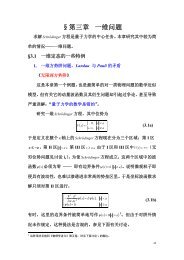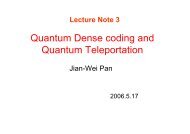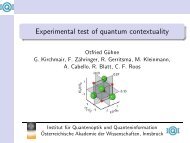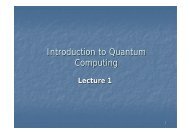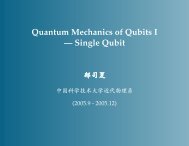Quantum Information Science with Trapped Ca+ Ions with Trapped ...
Quantum Information Science with Trapped Ca+ Ions with Trapped ...
Quantum Information Science with Trapped Ca+ Ions with Trapped ...
You also want an ePaper? Increase the reach of your titles
YUMPU automatically turns print PDFs into web optimized ePapers that Google loves.
<strong>Quantum</strong> <strong>Information</strong> <strong>Science</strong><br />
<strong>with</strong> <strong>Trapped</strong> Ca + <strong>Ions</strong>
<strong>Quantum</strong> <strong>Information</strong> <strong>Science</strong><br />
<strong>with</strong> <strong>Trapped</strong> Ca + <strong>Ions</strong><br />
Rainer Blatt<br />
Institute of Experimental Physics, University of Innsbruck,<br />
Institute of <strong>Quantum</strong> Optics and <strong>Quantum</strong> <strong>Information</strong>,<br />
Austrian Academy of <strong>Science</strong>s<br />
• <strong>Trapped</strong> Ca + for quantum information processing<br />
• Tffli Toffoli gate <strong>with</strong> trapped ions<br />
• Mølmer-Sørensen high fidelity gate operation<br />
• <strong>Quantum</strong> computation <strong>with</strong> logical qubits<br />
• Testing quantum mechanics <strong>with</strong> trapped ions<br />
FWF<br />
CONQUEST<br />
Industrie<br />
IQI<br />
€<br />
SFB SCALA Tirol<br />
GmbH<br />
$
The requirements for quantum computation<br />
D. P. DiVincenzo, Quant. Inf. Comp. 1 (Special), 1 (2001)<br />
I. Scalable physical system, well characterized qubits<br />
II.<br />
III.<br />
Ability to initialize the state of the qubits<br />
Long relevant coherence times, much longer than gate operation time<br />
IV.<br />
“Universal” set of quantum gates<br />
V. Measurement capability specific to implementation<br />
VI.<br />
VII.<br />
Ability to interconvert stationary and flying qubits<br />
Ability to faithfully transmit flying qubits between specified locations<br />
The seven commandments for QC !!
<strong>Quantum</strong> information processing <strong>with</strong> trapped ions<br />
control bit<br />
target bit<br />
other gate proposals (and more):<br />
• Cirac & Zoller<br />
• Mølmer & Sørensen, Milburn<br />
• Jonathan & Plenio & Knight<br />
• Geometric phases<br />
• Leibfried & Wineland
Qubits <strong>with</strong> trapped ions<br />
Storing and keeping quantum information requires long-lived atomic states:<br />
• optical transition frequencies<br />
(forbidden transitions,<br />
intercombination lines)<br />
S – D transitions in alkaline earths:<br />
Ca + , Sr + , Ba + , Ra + , (Yb + , Hg + ) etc.<br />
• microwave transitions<br />
(hyperfine transitions,<br />
Zeeman transitions)<br />
alkaline earths:<br />
9<br />
Be + , 25 Mg + , 43 Ca + , 87 Sr + ,<br />
137<br />
Ba + , 111 Cd + , 171 Yb +<br />
P 1/2<br />
D 5/2<br />
S 1/2<br />
P 3/2<br />
TLS<br />
S 1/2<br />
TLS<br />
S 1/2 Boulder 9 Be + ; Michigan 111 Cd + ;<br />
Innsbruck 40 Ca + Innsbruck 43 Ca + , Oxford 43 Ca + ;<br />
Maryland 171 Yb + ;
Level scheme of Ca +<br />
P 3/2<br />
854 nm<br />
qubit on narrow S - D<br />
quadrupole transition<br />
1<br />
s<br />
P 1/2<br />
393 nm<br />
397 nm<br />
866 nm<br />
D 5/2<br />
D 3/2<br />
729 nm<br />
40 Ca +<br />
S 1/2
Innsbruck linear ion trap (2000)<br />
1.0 mm<br />
6 mm
Detection of 6 individual ions
Spectroscopy of the S 1/2 –D 5/2 transition<br />
P 1/2 D 5/2<br />
2 level system:<br />
Fluorescence<br />
detection<br />
2-level-system:<br />
S 1/2<br />
Zeeman structure in<br />
non-zero magnetic field:<br />
D 5/2<br />
-3/2 -1/2 1/2 3/2<br />
-5/2<br />
3/2<br />
5/2<br />
<br />
sideband<br />
+ vibrational<br />
quantum<br />
cooling<br />
degrees of<br />
state<br />
S 1/2<br />
1/2 freedom processing<br />
-1/2
Quantized Ion Motion<br />
2-level-atom<br />
harmonic trap<br />
coupled system<br />
excitation: various resonances<br />
spectroscopy: carrier and sidebands<br />
n = 0<br />
D 5/2<br />
n = 1<br />
n = -1<br />
S 1/2<br />
n = 0 1 2<br />
<br />
Laser detuning
Coherent state manipulation<br />
D,0<br />
D ,1<br />
carrier<br />
(C)<br />
S,1<br />
S,0<br />
carrier and sideband<br />
Rabi oscillations<br />
<strong>with</strong> Rabi frequencies<br />
blue sideband<br />
(BSB)<br />
Lamb-Dicke parameter
<strong>Quantum</strong> information processing <strong>with</strong> trapped ions<br />
►algorithms:<br />
sequence of single qubit and<br />
two-qubit gate operations<br />
►gate operations:<br />
sequences of laser pulses<br />
(carrier and/or sideband pulses)<br />
carrier sideband<br />
d<br />
►analysis: l i<br />
measure density matrix of<br />
state or process (tomography)<br />
measure entanglement<br />
g<br />
via parity oscillations
Scalable push-button generation of GHZ states<br />
Fidelity<br />
Fidelity
Eight – Ion W state<br />
Fidelity: 0.76<br />
6561 settings,<br />
~ 10 h measurement time,<br />
but reconstruction time:<br />
~ several days on a<br />
computer cluster<br />
genuine<br />
e<br />
8-particle<br />
entanglement !<br />
The<br />
<strong>Quantum</strong> Byte<br />
H. Häffner et al., Nature 438, 643 (2005)
<strong>Quantum</strong> Process Tomography<br />
control bit<br />
target bit<br />
target bit<br />
control bit<br />
characterizes gate operation completely
– matrix for observed CNOT gate operation
– matrix for observed CNOT gate operation
Scalable quantum computation requires error correction
Toffoli gate: controlled-controlled NOT<br />
Toffoli gate (Tommaso Toffoli, 1980):<br />
…… is a universal reversible logic gate, i.e. any reversible circuit can<br />
be constructed from Toffoli gates.<br />
also known as the controlled-controlled-NOT or CCNOT-gate operation<br />
useful, e.g. for error correction
Toffoli gate: pulse sequence<br />
use 2-phonon excitation<br />
Th. Monz et al.,<br />
Phys. Rev. Lett. 102, 040501 (2009)<br />
B B B B B B B B<br />
B<br />
B<br />
effective <br />
for n=1,2<br />
result:<br />
n=1 iff SS<br />
C B B B C<br />
CNOT<br />
iff n=1<br />
undo encoding,<br />
reverse phases
Toffoli gate: experimental truth table<br />
density matrix<br />
State Fidelity<br />
Th. Monz et al., Phys. Rev. Lett. 102, 040501 (2009)
Toffoli gate: process tomography<br />
- matrix for ideal TOFFOLI gate operation<br />
III<br />
IIXIIY<br />
IIYIIZIXI<br />
ZZZ<br />
ZZZ<br />
III
Toffoli gate: process tomography<br />
- matrix for the real TOFFOLI gate operation<br />
Mean<br />
Process Fidelity<br />
Th. Monz et al., Phys. Rev. Lett. 102, 040501 (2009)
<strong>Quantum</strong> procedures and fidelities<br />
► single qubit operations > 99 %<br />
► 2-qubit CNOT gate ~ 93 %<br />
► Bell states<br />
► W and GHZ states<br />
93-95 %<br />
85-90 %<br />
► <strong>Quantum</strong> teleportation 83 %<br />
► Entanglement swapping<br />
~ 80 %<br />
► Toffoli gate operation 71 %<br />
!<br />
BUT: for fault-tolerant operation needed > 99 %
Mølmer - Sørensen gate - operation<br />
bichromatic laser excitation<br />
close to upper and lower<br />
sidebands induces collective<br />
state changes (spin flips)<br />
K. Mølmer, A. Sørensen,<br />
Phys. Rev. Lett. 82, 1971 (1999)<br />
C. A. Sackett et al.,<br />
Nature 404, 256 (2000)
measure the parity :<br />
Measuring entanglement<br />
C. A. Sackett et al., Nature 404, 256 (2000)<br />
Ion 1<br />
Ion 2<br />
/2<br />
<br />
CNOT /2 <br />
/2 <br />
oscillates t <strong>with</strong> 2<br />
54% visibility<br />
Fidelity =<br />
0.5(P SS +P DD +visibility) =<br />
71(3) %<br />
F. Schmidt-Kaler et al., Nature 422, 408 (2003)
Deterministic Bell states using the Mølmer-Sørensen gate<br />
entangled<br />
J. Benhelm, G. Kirchmair,<br />
C. Roos<br />
Theory: C. Roos,<br />
New Journ. of Physics 10,<br />
013002 (2008)<br />
measure entanglement<br />
via parity oscillations<br />
gate duration<br />
average fidelity
Mølmer-Sørensen gate: thermal states<br />
Gate operation after ground Doppler state cooling cooling<br />
Fidelity :<br />
F=98 99.3(1) 98.0(1) %<br />
Gate operation ≈ independent of motional state !<br />
G. Kirchmair et al., New. J. Phys. 11, 023002 (2009)
Collective entangling gates + individual light shifts<br />
N ions<br />
Basic set of operations:<br />
Mølmer-Sørensen gate<br />
individual light shift gates<br />
collective spin flips<br />
+ + + + +<br />
● favorable ion addressing by light shifts (~ 2 )<br />
● no interferometric stability between beams required<br />
Arbitrary unitary operations can be achieved !<br />
...but how
Optimal control for arbitrary quantum gates<br />
<strong>Quantum</strong> optimal control:<br />
V. Nebendahl et al.,<br />
Phys. Rev. A 79,<br />
012312 (2009)<br />
Find<br />
such that<br />
Gradient ascent algorithm: N. Khaneja et al., , J. Magn. Res. 172, , 296 (2005)<br />
Modification of search algorithm:<br />
Example: quantum Toffoli gate<br />
● no simultaneous application of several Hamiltonians<br />
● sequence of pulses <strong>with</strong> variable length<br />
1<br />
2<br />
=<br />
3
Optimal control : <strong>Quantum</strong> Error Correction<br />
<strong>Quantum</strong> Error Correction: 3 qubits encode logical qubit (protection against spin flips)<br />
spin flip errors<br />
spin flip errors<br />
encoding<br />
reset ancillas<br />
error syndrome<br />
detection<br />
correction<br />
step<br />
Implementation : 34 laser pulses (11 entangling pulses)<br />
V. Nebendahl et al.,<br />
Phys. Rev. A 79,<br />
012312 (2009)
Scalability is facilitated by error avoidance<br />
Decoherence-free Bell states:<br />
C. Roos et al., Phys. Rev. Lett. 92, 220402 (2004)<br />
decoherence-time:<br />
0.5 x 1.05(15) s
prepare qubits<br />
in S states<br />
t<br />
D 1/2 3/2<br />
-1/2<br />
Robust entanglement<br />
5/2<br />
H. Häffner et al., Appl. Phys. B 81, 151 (2005)<br />
Hiding states in S, S‘ states<br />
avoids decoherence from<br />
-5/2 -3/2 spontaneous emission<br />
D 5/2<br />
S 1/2<br />
S<br />
-1/2<br />
1/2<br />
S‘
<strong>Quantum</strong> gates <strong>with</strong>in a decoherence free subspace<br />
Idea: use long-lived Bell states as logical qubits<br />
K. Kim et al., Innsbruck, 2006<br />
Gate operations by<br />
- addressing individual ions<br />
- simultaneous addressing of innermost ions<br />
Trade off more ions (2x) for much extended coherence times (100-1000x)
Universal quantum computation <strong>with</strong> logical qubits<br />
Idea: use long-lived Bell states as logical qubits<br />
Th. Monz, K. Kim,<br />
Ph. Schindler (2008)<br />
Gate operations by<br />
- addressing individual ions and MS-gates<br />
- simultaneous addressing of innermost ions<br />
1 st experiment:<br />
Analysis by state and process tomography
Gate operations <strong>with</strong> logical qubits<br />
Z<br />
Z<br />
K. Kim et. al.<br />
Phys. Rev. A77, 050303 (2008)<br />
X<br />
C. Roos,<br />
New Journ. Phys. 10 (2008)<br />
Z<br />
single qubit phase shift by<br />
AC Stark shifts<br />
F. Schmidt-Kaler et. al.<br />
Europhys. Lett. 65, 587 (2004)
CNOT gate operation <strong>with</strong> a logical qubit<br />
spin echo
theory<br />
Process tomography of CNOT <strong>with</strong> logical qubits
Process tomography of CNOT <strong>with</strong> logical qubits<br />
experiment<br />
mean gate fidelity
<strong>Quantum</strong> state manipulation <strong>with</strong> logical qubits<br />
results and limitations:<br />
● mean gate fidelity: 89(4)%<br />
● limited by addressing errors, spurious laser noise, position stability,<br />
equal illumination of neighbouring ions<br />
advantages:<br />
● insensitive to laser linewidth,<br />
● insensitive to AC-Stark shifts<br />
(work in progress)<br />
● lifetime limited coherence time<br />
(work in progress)
Testing quantum mechanics <strong>with</strong> trapped ions<br />
• Do observables have predetermined values,<br />
fixed by hidden variables<br />
J. S. Bell<br />
“No physical theory<br />
of local hidden<br />
variables can<br />
reproduce all of<br />
the predictions of<br />
quantum mechanics” S. Kochen E. Specker<br />
“Non‐contextual t lhidden<br />
variable theory cannot<br />
reproduce the predictions of<br />
quantum mechanics”
Kochen‐specker theorem<br />
“Non‐contextual hidden variable theory cannot<br />
reproduce the predictions of quantum mechanics”<br />
Non‐Contextuality<br />
Any measurement A should give a value independent<br />
of other compatible measurements B :<br />
(AB) = (A) ∙ (B)<br />
Experimental tests:<br />
Huang, Y.F., Phys. Rev. Lett. 90, 250401 (2003)<br />
Hasegawa, Y., Phys. Rev. Lett. 97, 230401 (2006)<br />
Specker, R., Dialectica 14, 239‐246 (1960)<br />
Bell, J.S., Rev. Mod. Phys. 38, 447‐452 (1966)<br />
Kochen, S., & Specker, E.P., J. Math. Mech. (1967)
The Peres – Mermin square<br />
Measure observables<br />
A ij<br />
<strong>with</strong> v(A ij<br />
) = ±1,<br />
where the observables<br />
in each row and column<br />
are mutually compatible<br />
A. Peres, Phys. Lett. A 151, 107–108 (1990)<br />
N. D. Mermin, Phys. Rev. Lett. 65, 3373–3376 (1990)<br />
<br />
(1)<br />
z <br />
(2)<br />
z <br />
(1)<br />
z <br />
(2)<br />
z R 1 =1<br />
1<br />
z z z z<br />
(2) x <br />
(1)<br />
x <br />
(1)<br />
x <br />
(2)<br />
x R 2 =11<br />
z<br />
(1) x<br />
(2)<br />
x<br />
(1) z<br />
(2)<br />
y<br />
(1) y<br />
(2)<br />
R 3 =1<br />
C 1 =1 C 2 = 1 C 3 = ‐1
Testing the Kochen‐Specker theorem<br />
● KS = R 1 + R 2 + R 3 + C 1 + C 2 ‐ C 3 <br />
● Non‐contextual hidden variable theory<br />
KS ≤ 4<br />
● quantum mechanics<br />
KS =6<br />
<br />
(1) z <br />
(2) z <br />
(1) <br />
(2)<br />
z z<br />
R 1 =1<br />
for any input state <br />
(2)<br />
x <br />
(1)<br />
x <br />
(1)<br />
x <br />
(2)<br />
x<br />
R 2 =1<br />
z<br />
(1) x<br />
2<br />
x<br />
(1) z<br />
(2)<br />
y<br />
(1) y<br />
(2)<br />
R 3 =1<br />
C 1 =1 C 2 = 1 C 3 = ‐1<br />
A. Cabello, Phys. Rev. Lett. 101, 210401 (2008)
Measuring operators like x x<br />
(1) (2) (1) (2)<br />
z z z z<br />
(2) x <br />
(1)<br />
x <br />
(1)<br />
x <br />
(2)<br />
x<br />
z<br />
(1) x<br />
(2)<br />
x<br />
(1) z<br />
(2)<br />
y<br />
(1) y<br />
(2)<br />
We have to measure all observables <strong>with</strong> the same setup<br />
whether measured in a row or a column map to single ion
Experimental procedure<br />
Measurement scheme for rows and columns of PM square:<br />
unitary for respective<br />
element of PM square<br />
actual measurement
Results<br />
z<br />
(1)<br />
z<br />
(2)<br />
z<br />
(1) z<br />
(2) R 1 =0.92(1)<br />
Input state:<br />
|SS |DD<br />
<br />
(2)<br />
x <br />
(1)<br />
x <br />
(1)<br />
x <br />
(2)<br />
x R 2 =0.93(1) 0 z<br />
(1) x<br />
2<br />
x<br />
(1) z<br />
(2)<br />
y<br />
(1) y<br />
(2) R 3 =0.90(1)<br />
C =0.90(1) C = 0.89(1)C = ‐0.91(1) 1 2 3 = 5.46(4)<br />
KS > 4
State independence<br />
States are prepared <strong>with</strong> 97(2) % fidelity (quantum state tomography)<br />
KS avg = 5.38(4)<br />
> 4<br />
State independence
Simulating the Dirac equation<br />
… <strong>with</strong> a single trapped ion
Simulating the Dirac equation<br />
Lamata et al., PRL 98, 253005 (2007)<br />
The Dirac equation<br />
can be cast in a 1+1 dimensional form (1 spatial + 1 spin degree of freedom)<br />
resonant bichromatic excitation<br />
Stark shift<br />
<strong>with</strong> the replacements
<strong>Quantum</strong> <strong>Information</strong> <strong>Science</strong> <strong>with</strong> <strong>Trapped</strong> <strong>Ions</strong><br />
Ca + for quantum information processing<br />
<strong>Quantum</strong> process tomography, gate operations<br />
Toffoli gate <strong>with</strong> trapped ions<br />
Mølmer-Sørensen high fidelity gate operation<br />
<strong>Quantum</strong> gate operations <strong>with</strong> logical qubits<br />
Testing quantum mechanics <strong>with</strong> trapped ions<br />
Simulating the Dirac equation <strong>with</strong> a trapped ion<br />
Future:<br />
further optimization of logic operations<br />
error correction protocols <strong>with</strong> three and five qubits<br />
implementation <strong>with</strong> 43 Ca + , logical qubits + scalability<br />
miniaturize traps, interface quantum information
Future goals and developments<br />
more qubits (~20 – 50)<br />
better fidelities<br />
faster gate operations<br />
faster detection<br />
cryogenic trap, micro-structured traps<br />
development of 2-d trap arrays, onboard addressing, electronics etc.<br />
entangling of large(r) systems: characterization <br />
implementation of error correction, keep „qubit alive“<br />
applications<br />
- small scale QIP (e.g. repeaters)<br />
- quantum metrology, enhanced S/N, tailored atoms and states<br />
- quantum simulations<br />
- quantum computation
The international Team 2008<br />
€<br />
FWF<br />
SFB<br />
CONQUEST<br />
SCALA<br />
Industrie<br />
Tirol<br />
IQI<br />
GmbH<br />
$
The international Team 2008<br />
C. Roos<br />
H. Häffner<br />
W. Hänsel<br />
P. Schmidt<br />
M. Hennrich<br />
R. Gerritsma<br />
F. Dubin<br />
K. Kim<br />
A. Villar<br />
M. Brownnutt<br />
N. Daniidilis<br />
T. Northup<br />
J. Barreiro<br />
G. Hetet<br />
M. Riebe<br />
J. Benhelm<br />
C. Russo<br />
H. Barros<br />
F. Splatt<br />
S. Narayanan<br />
F. Zähringer<br />
P. Schindler<br />
B. Brandstädter<br />
M. Kumph<br />
A. Stute<br />
M. Harlander<br />
B. Hemmerling<br />
M. Chwalla<br />
Th. Monz<br />
G. Kirchmair<br />
S. Gerber<br />
L. Slodička<br />
M. Niedermair<br />
L. Anderlan<br />
V. Nebendahl<br />
R. Lechner<br />
D. Nigg<br />
€<br />
FWF<br />
SFB<br />
CONQUEST<br />
SCALA<br />
Industrie<br />
Tirol<br />
IQI<br />
GmbH<br />
$



